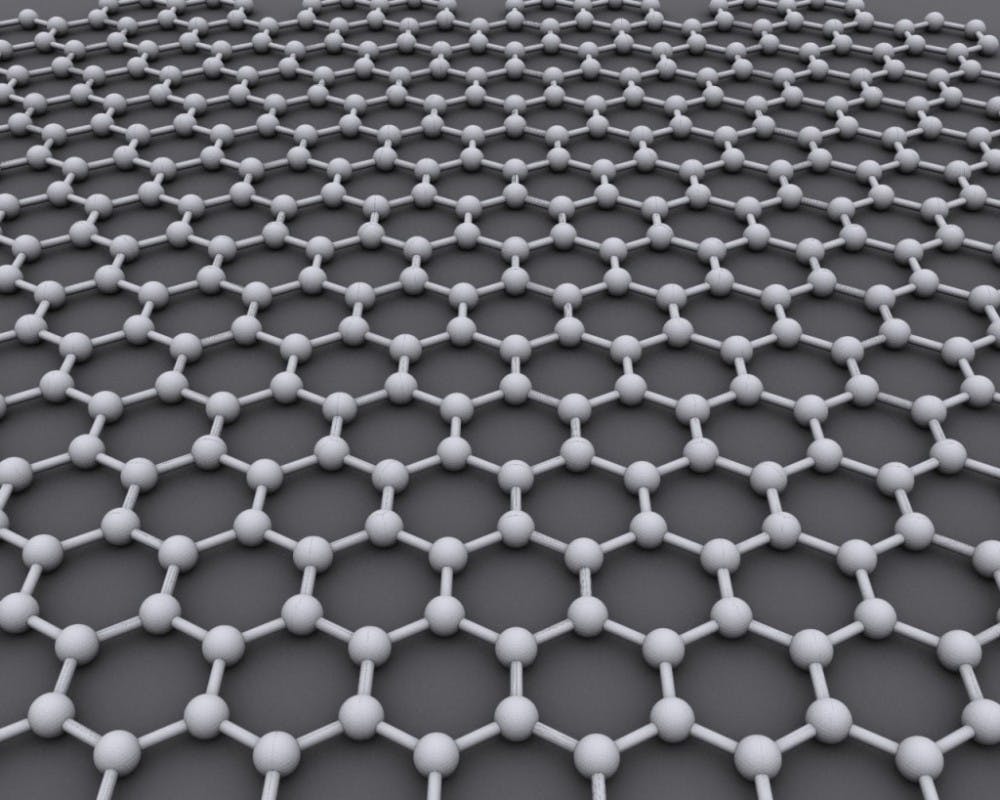Graphene is a two dimensional, ultra-conductive material that may be the key to understanding current astronomical phenomena, such as black holes and supernova. Originally isolated in 2004 by professors Andre Geim and Kostya Novoselov at the University of Manchester, Graphene could have the potential to advance our understanding of relativistic physics and completely revamp current electric industrial products. This so-called “wonder material” essentially consists of a one-atom-thick carbon sheet composed of a honeycomb-like network of atoms.
As one of the most conductive materials on earth, graphene holds potential for increasing battery efficiency, replacing silicon in electronics and leading the pursuit of cheap thermal electricity. The material is also stronger than steel, harder than diamond and proven to have the potential to act as a superconductor. In order to begin to harness and utilize the unique properties that graphene possesses, scientists continue to strive to better understand the metal’s physical properties and to discover a simpler way to manufacture the metal in a pure form.
Researchers at Harvard University and Raytheon BBN Technology just published results revealing yet another unique property of the metal: its compliance with the laws of hydrodynamics. Rather than act as particles of a solid, as one would expect it to do, the electrons in graphene behave as if they are part of a fluid. The fluid-like properties of graphene were discovered by a team of scientists, led by Philip Kim, professor of physics and applied physics at the Harvard John A. Paulson School of Engineering and Applied Sciences (SEAS), only after they had found a way to isolate graphene in an ultra-clean form. The researchers were able to create an extremely pure sample of graphene by sandwiching the one-atom-thick layers between 10 layers of electrically insulating perfectly transparent crystal with an atomic structure mimicking that of the graphene itself.
“If you have a material that’s one atom thick, it’s going to be really affected by its environment,” Jesse Crossno, a graduate student in the Kim Lab and first author of the paper, said in a press release. “If the graphene is on top of something that’s rough and disordered, it’s going to interfere with how the electrons move. It’s really important to create graphene with no interference from its environment.”
The sandwich technique was developed by Kim at Columbia University, and he continued working on it at Harvard University since 2014. The final step to isolating pure graphene in order to observe its electron flow was to make a thermal soup of positive and negative particles on the surface of the graphene. Using the flow of the particles in the soup, researchers could form conclusions about the particle flow within graphene.
“Instead of watching how a single particle was affected by an electric or thermal force, we could see the conserved energy as it flowed across many particles, like a wave through water,” Crossno said.
In a three-dimensional metal, electrons rarely interact. What was observed in graphene was almost the opposite — the electrons formed an electron “superhighway” of sorts. They moved as massless relativistic objects, some carrying positive charge and others carrying negative charge. The movement is described as a superhighway because the particles all move as if trapped in a single lane. The particle speeds hover around 1/300 of the speed of light, translating to a predicted 10 trillion collisions per second at room temperature.
The potential of graphene within the realm of physics is immense. In regards to our current understanding of the physical world, physicists rely upon three primary, and often distinct, sets of laws. For everyday physical action, such as how a fluid flows or the trajectory of a bullet shot out of a gun, classical physics is sufficient. When it comes to very small objects, like electrons, quantum mechanics is used. Large, fast objects like galaxies are described by relativistic physics. What graphene does is help to bridge the gap between these distinct sets of laws. Some of the only other objects through which more than one branch of physics can be observed include black holes and other high-energy systems, all of which are impossible to experiment on. Graphene’s fluid electron movement, which obeys hydrodynamics, and its particles’ observance of relativistic physics, allows it to bridge a gap among the laws of physics.
“Physics we discovered by studying black holes and string theory, we’re seeing in graphene,” Andrew Lucas, co-author and graduate student with Subir Sachdev, the Herchel Smith Professor of Physics at Harvard University, said in a press release. “This is the first model system of relativistic hydrodynamics in a metal.”
Pieces of graphene could one day be used to model other high energy systems.
Beyond the potential the metal holds for the realm of physics, scientists are also working to harness graphene’s unique ability to transmit thermal energy using the high-speed flow of its electrons. Thermal energy is produced through two methods in a material: Through vibrations in atomic structure and through the electrons themselves.
The researchers wanted to focus only on the heat that is carried by the electrons and not on the lattice itself.
In order to do so, the team decided to look into noise — at a finite temperature electrons move randomly, and the higher the temperature the “noisier” they get. The correlation between electron movement and noise enabled researchers to use the noisiness of the electrons as a medium through which to isolate the energy of the electrons from that of the atomic vibrations. Quantifying the thermal energy of the electrons in graphene is the first step towards applying it to electronic devices. Because the electrons in graphene have no mass and flow with no resistance, the conductivity of the material could lead to the realization of a high-speed nano-electronic device.
“Converting thermal energy into electric currents and vice versa is notoriously hard with ordinary materials,” Lucas said. “But in principle, with a clean sample of graphene there may be no limit to how good a device you could make.”





